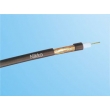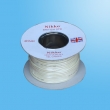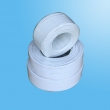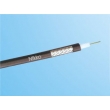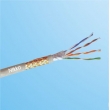Electric wire–more correctly known as “cable”–comes in a variety of sizes (gauges) and insulators depending on its function. Each type of insulation, or sheathing, serves a specific function, and it can be dangerous to use inappropriately sheathed cable in certain situations. Conversely, using heavier-than-necessary cable is a waste of money. Knowing what type of electric cable to use in a given situation is an important part of any electrical project.
Nonmetallic Sheathed Cable
The most common cable used in construction is nonmetallic sheathed, usually abbreviated NM cable. As the name implies, NM cable is a set of wires, usually three or four strands, encased in a cardboard or heavy paper sheath and coated in a plastic casing. NM cable is used in locations where it cannot get wet and is unlikely to be damaged; normally this cable is used behind walls and ceilings. Each cable contains a code on the plastic sheath that describes its gauge or thickness and how many wires are inside. For example, a cable encoded as “14-2-G” is two-wire, 14-gauge, grounded cable, which means it is acceptable for a 15-amp circuit and contains hot and neutral wires and a ground wire. Cable labeled “12-3-G” is suitable for a 20-amp circuit and contains two hot wires and a ground.
BX Cable
BX cable comes in two- and three-wire versions and contains wires wrapped in a flexible metallic sheath. BX cable does not contain a ground wire because the metallic sheath serves this purpose. Normally BX cable is used in places exposed to moisture, like basements. The metal sheath protects the wires from moisture, but the gauge of the wires still determines the amount of current the cable can carry. There is no advantage in using BX cable in a place where NM cable will suffice.
Greenfield Conduit
Greenfield conduit resembles BX cable but is not electrical cable. Instead greenfield is a hollow metal tube through which wires are pulled. Electricians use greenfield for added protection for wiring in locations exposed to extreme conditions. Greenfield has the advantage of allowing for wiring upgrades because the cable inside can simply be replaced with heavier-gauge wiring should circumstances demand it.



